#830 A Lonely Neutron Star September 26, 1997
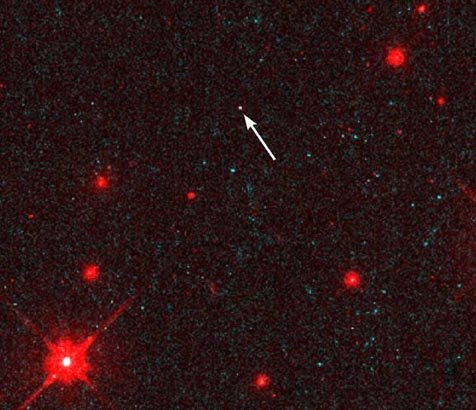
“How massive can a star get without imploding into a black hole? These limits are being tested by the discovery of a lone neutron star in space. Observations by the Hubble Space Telescope released Wednesday, have been combined with previous observations by the X-ray ROSAT observatory and ultraviolet EUVE observatory for the isolated star at the location of the arrow. Astronomers are able to directly infer the star's size from measurements of its unblended brightness, temperature, and an upper limit on the distance. Assuming that the object is a neutron star of typical mass, some previous theories of neutron star structure would have predicted an implosion that would have created a black hole. That this neutron star even exists therefore allows a window to the extreme conditions that exist in the interiors of neutron stars."
Copyright: Public domain
#831 The Ecliptic Plane September 27, 1997
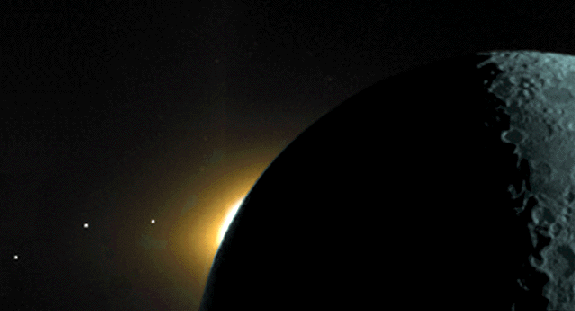
“The Plane of the Ecliptic is illustrated in this Clementine star tracker camera image which reveals (from right to left) the Moon lit by Earthshine, the Sun's corona rising over the Moon's dark limb, and the planets Saturn, Mars, and Mercury. The ecliptic plane is defined as the imaginary plane containing the Earth's orbit around the Sun. In the course of a year, the Sun's apparent path through the sky lies in this plane. The planetary bodies of our solar system all tend to lie near this plane, since they were formed from the Sun's spinning, flattened, proto-planetary disk. The snapshot above nicely captures a momentary line-up looking out along this fundamental plane of our solar system."
Copyright: Public domain
#832 A Wolf Rayet Star Bubble September 28, 1997
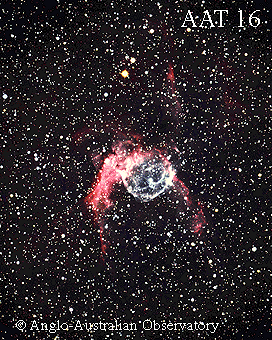
“What's a Wolf-Rayet star, and how did it create that spherical bubble and sweeping arc? A Wolf-Rayet star is a star that originated with a mass over 40 times that of our Sun. An extremely hot, luminous star, it has since expelled shells of material through its strong stellar wind which could account for the bubble shaped nebula that surrounds it. But astronomers are unsure how the central Wolf-Rayet created both the bubble and the arc seen above, and even whether it acted alone in doing so. Together, this bubble and the arc are known as NGC 2359."
Copyright: Anglo-Australian Telescope
Board
#833 Jupiter And Family September 29, 1997
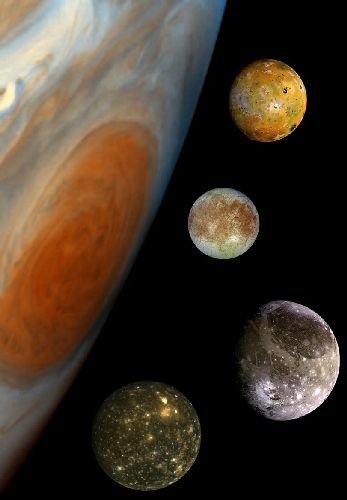
“Tomorrow's picture: Half Dome Rock on Mars"
Copyright: Public domain
#834 Half Dome Rock on Mars September 30, 1997
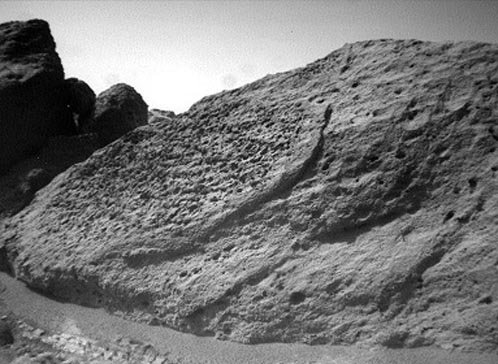
“Who ordered the Martian pizza? As Mars Pathfinder and its mobile robot Sojourner continue to explore Mars, new and interesting rocks are being discovered, even though the primary mission has been successfully completed. The rock pictured above has been dubbed "Half Dome" and was visited by Sojourner in late August. The shape and fine-scale textures of Half Dome are still being studied. As part of the extended mission, Sojourner has been sent on its longest journey yet - a 50 meter stroll around the Sagan Memorial Station."
Copyright: Public domain
#835 Maria Mitchell Inspires a Generation October 01, 1997

“"Do not look at stars as bright spots only - try to take in the vastness of the universe." Today is the 150th anniversary of the day Maria Mitchell swept the sky with her telescope and discovered the comet of 1847 (comet Mitchell 1847VI). Honored and recognized internationally for her discovery, Mitchell, who lived from 1818 to 1889, became one of the most famous American scientists of her day. Vassar College appointed Mitchell the first woman Professor of Astronomy and she remained the only woman ever elected to the American Academy of Arts and Sciences until 1943. Mitchell mentored a generation of scientists, and is fondly remembered for her ability to motivate. "We especially need imagination in science," Maria Mitchell said. "Question everything.""
Copyright: Public domain
#836 Colliding Supernova Remnants October 02, 1997
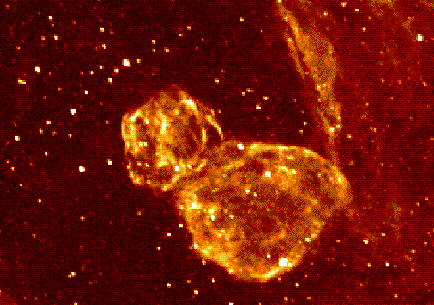
“When a massive star exhausts its nuclear fuel it explodes. This stellar detonation, a supernova, propels vast amounts of starstuff outwards, initially at millions of miles per hour. For another 100,000 years or so the expanding supernova remnant gradually slows as it sweeps up material and ultimately merges with the gas and dust of interstellar space. Short lived by cosmic standards, these stellar debris clouds are relatively rare and valuable objects for astronomers exploring the life cycles of stars. Yet this double bubble-shaped nebula 160,000 light-years away in the Large Magellanic Cloud may represent something rarer still - the collision of two supernova remnants. This image in the light of excited Hydrogen atoms along with images at X-Ray, radio and other optical wavelengths, suggests that the bubbles are indeed two separate regions of hot gas surrounded by cooler dense shells begining to interact as they expand and make contact."
Copyright: Public domain
#837 Comet Halley and the Milky Way October 03, 1997
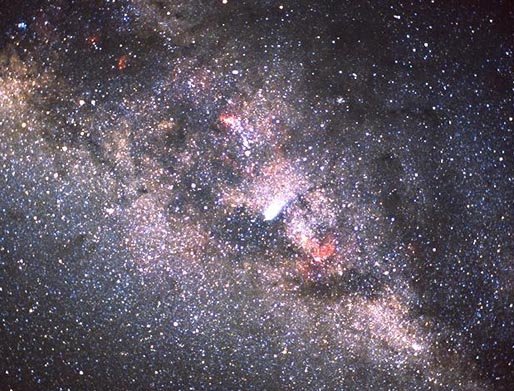
“Comet Halley was photographed superposed in front of the disk of our Milky Way Galaxy in 1986 by the Kuiper Airborne Observatory. Comet Halley is the bright white streak near this photograph's center. Comet Halley is the most famous comet in history, and returns to the inner Solar System every 76 years. Stars visible in our Milky Way Galaxy typically lie millions of times farther in the distance and orbit the Galactic center every 250 million years. Billions of comets are thought to orbit our Sun but most do not get close enough for us to see. Similarly, billions of stars orbit our Milky Way's center but do not get close enough for us to see."
Copyright: Public domain
#838 In the Center of 30 Doradus October 04, 1997

“In the center of 30 Doradus lies a huge cluster of the largest, hottest, most massive stars known. The center of this cluster, known as R136, is boxed in the upper right portion of the above picture. The gas and dust filling the rest of the picture is predominantly ionized hydrogen from the emission nebula 30 Doradus. R136 is composed of thousands of hot blue stars, some about 50 times more massive than our Sun. 30 Doradus and R136 lie in the LMC - a satellite galaxy to our own Milky Way Galaxy. Although the ages of stars in R136 cause it to be best described as an open cluster, R136's density will likely make it a low mass globular cluster in a few billion years."
Copyright: Public domain
#839 Worlds of a Distant Sun: 47 Ursae Majoris b October 05, 1997
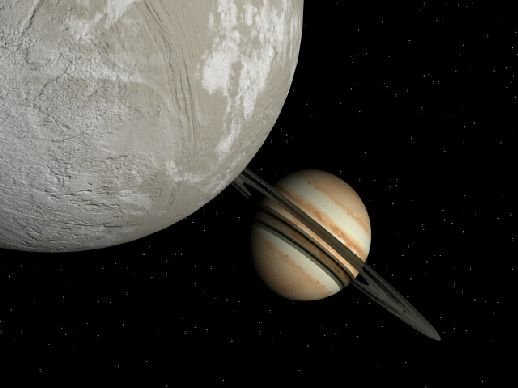
“In the last few years, observational astronomy has given humanity evidence of the existence of worlds beyond the solar system. Solar-type stars are now inferred to harbor planets of approximately Jupiter mass - some residing in temperature zones which could conceivably support liquid water and therefore life! Above is a hypothetical scene near one such planet whose sun, 47 Ursae Majoris (47 UMa), is very similar to our own. In our sky, 47 UMa appears as a faint, inconspicuous star below the cup of the "the Big Dipper". (Our own sun would be equally inconspicuous when viewed from 47 UMa ...) Astronomers G. Marcy and P. Butler announced the discovery of a planet associated with this star in 1996 and reported it to have a mass of about 2.4 Jupiters or more with an orbital period of 3 years. This artist's extrasolar vision pictures the detected planet, 47 UMa b, as a gas giant surrounded by a ring of material - analogous to our own gas giant Saturn. In the foreground lies a hypothetical moon of 47 UMa b. Could such a moon support life? 47 UMa is only 44 light years distant, fairly close by astronomical standards - yet there is evidence for planetary systems which are closer still. NASA plans to explore nearby planetary systems using spaceborne observatories."
Copyright: Extrasolar Visions
Upvote! Resteem! Comment! As you like it! Thank you for attention!